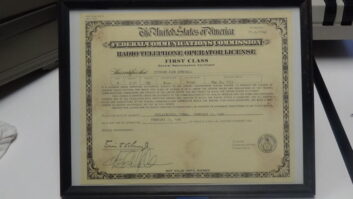Many predictions that radio is dead have been made over the years and now Barron’s and Forbes are the latest to espouse that view. In back-to-back articles, stories in both publications essentially call radio a musty old technology not worth investing in. The latest Barron’s shows a radio covered in cobwebs on the cover, along with the sub hed: “America’s old standby for news and music is fast losing young listeners. The outlook for the industry’s stocks is bleak.”
“It’s over,” states a Larry Haverty, a media stock analyst for State Street Research and Management in Boston to Barron’s. “Something good happened in the ‘Nineties; something less good has happened in the ’00s. Every retailer is blowing its budget on advertising and radio is not getting any of it. If they don’t get it now, they’re not going to.”
Although the economic recovery has been underway for two years, the prognosis for radio is “grim” states Barron’s, quoting media-spending forecaster Robert Coen of Universal McCann as previously expecting 7% growth on national radio ad spending this year. But it’s running closer to 1%. Local ads, he predicted, would increase 6% this year over last; so far, it’s about 4% more.
Advertising has decreased as radio listening among younger listeners has dropped and advertisers have shifted their money into other areas, such as the Internet, according to Haverty.
The stock price for Clear Channel, Citadel and Cumulus is off by 17%, 33% and 29% this year respectively; notes Barron’s, yet it also acknowledges that cash flow for the major radio groups is up.
Although Barron’s has the sky falling on radio, Radio One COO Catherine Sneed asserts radio is in a recovery mode, but it may take two years to determine exactly what kind of recovery that will be.
Forbes, meanwhile, calls traditional radio “geriatric” in comparison to its satellite counterpart, yet at the same time it castigates traditional radio as “bullies” for having more listeners than XM and Sirius. This piece, out last week, describes NAB as lobbying regulators to hamper the success of the satcasters, without explaining that there were technical reasons related to early spectrum allocation hurdles for Sirius and XM.
The Forbes article, for example, lets the reader assume that NAB is responsible for the satellite radio companies eventually ending up being allowed to bid at auction for less spectrum than they originally thought they were receiving. (Remember just before the auction when then-FCC Chairman Reed Hundt suggested opening the bidding to everyone, when there were already four companies vying for just two slices of satellite radio-designated spectrum?)
What the Forbes article leaves out is the FCC decided to auction some of that spectrum to telecom companies at a higher price than the $200 million combined the satcasters paid for their portions of the S-band.
Barron’s, Forbes Think Radio is on The Ropes
Barron's, Forbes Think Radio is on The Ropes










